CDMX – estamos encantados
- RandE
- May 11, 2019
- 8 min read
Updated: May 14, 2019
First off, Toluca is not the airport for Mexico City. Who knew? We just accepted what our round the world ticket directed and assumed we’d land in a busy metropolis. Instead it was an easy to manage, quick taxi pick-up and a chance to see some of the capital’s outskirts: gum trees, good highways and an industrial business district with a new train line under construction. Then we hit Chapultepec Parque and with the help of Rick’s savvy commentary, knew we were in for a very special city.

CDMX 101
Fortunately, a few days exploring with a former resident gave us the “CliffsNotes” version of this sprawling, culturally rich city. It also helped save us from what we normally do adjusting to a new place – argue about where we are and where we should be going. On Rick’s advice, our Airbnb was in the Roma district (you may have heard of it from this year’s Oscars ;-)) near Plaza de Rio de Janeiro and the David knock-off fountain . Rick took us on 3 days walkabout to many of his favourite haunts and shared his take on what was important to experience in our timeframe. His friends Justino and Angel were welcoming and a good source for a local point of view on everything from the best tacos to the current political environment. It felt a bit like we were on the inside. We spent our first day wandering around Roma and Condesa, two of the neighbourhoods that have been going through a renaissance over the past ten years. The tree-lined streets and beautiful old homes are reminiscent of European capitals, influenced by the legacy of colonial powers that controlled Mexico for many years. Peaceful parks, cosy cafes and bourgie boutiques are everywhere with a touch of hipster thrown in. It’s amazing how ubiquitous that facial hair, man bun, skinny jean and on-point shirt has become. This certainly was not the Mexico City that we grew up hearing and fearing about.
On Easter Sunday, we left Roma with the Zocalo in our sights. We wandered through the Mercado de San Juan with its exotic chilis and edible insects, past the Palacio de Bellas Artes, through the stunning Downtown Hotel and Azul Historico’s fantastic selection of upscale local crafts, foods and art pieces before making it to the main square. The Zocalo was the ceremonial centre in the Mexica city of Tenochtitlan prior to the colonial period and still hosts spiritual cleansing ceremonies performed by the indigenous residents. It seemed like a bit of tourist pageantry until we stumbled on the Dia Mundial de la Madre Tierra parade heading there - still using this open plaza to celebrate their culture today.
Erik helped a student with her English, a déjà vu moment from a previous encounter in Vietnam and we saw concerts and school groups on subsequent visits. We were in sights and sounds overload that didn’t end as we moved away from this hub. Our non-stop trek brought us past the Angel of Independence (which Rick reminded us appeared in the overblown intro sequence of Netflix’s Sense8) finally stopping for a drink before landing back in our Roma home. It had been almost 6 hours of walking and worth every minute.
So far, for us, Ciudad de México's look and feel echoed the great cities of Europe, but on closer view was obviously “of Mexico”. On Rick’s last day, we explored a work by the architect Luis Barragan – celebrated for bringing modernism to the country and still holding true to tradition. Our tour of Casa Gilardi, the last private residence he built, gave us a personal viewpoint behind his legacy. It embodied the Mexico City we were beginning to uncover, and like the new Ciudad de Mexico (CDMX) branding, it was fresh, yet true to its past.

Frida and Diego and Art
You can’t visit Mexico City without seeing artists Frida Kahlo and Diego Rivera. Their images or images of their work are everywhere. Diego Rivera established a trust to ensure the integrity of the couple's artwork, but brand and image are a different story. We see Frida’s famous face on every tourist tchotchke imaginable and for some, the reason for her notoriety. We set out to see the work -- or at least the environments where it was created -- beginning our pilgrimage with a visit to the Museo Casa Estudio Diego Rivera and Frida Kahlo in San Angel.
The residences with studios, designed by their friend architect and artist Juan O'Gorman, were built as part of a compound in this upscale, leafy neighbourhood with mostly traditional hacienda-style homes. The harsh contrast of pure functionalism in architecture caused some locals to demand his license be revoked. Talk about making a statement! We noticed the bridge connecting the two lovers’ homes – reminiscent of the bridge connecting the Taylor-Burton homes in PV. Independent, yet needing connection. Diego’s light-filled studio contains a few of his works and many other collectibles that inspired him. It’s easy to imagine him painting there. Frida’s studio/house was more modest but also filled with beautiful light. Not much remains in her space and they were preparing for an exhibition, but we still walked around imagining all that creative energy – and the Latin “crazy” as Erik calls it between the two.
From San Angel, we hiked over to Coyoacan, the neighbourhood of Frida Kahlo’s family home Casa Azul. We had an evening tour scheduled with 10,000 other people – it is the most visited museum in Mexico -- and with time to spare, we wandered through the area checking out the markets, the coffee shops, historic centre and surrounding parks. From the Plaza de la Conchita, we stumbled upon the Parque Frida Kahlo with a life-size sculpture of Frida and Diego and some very cool mosaic murals. It was a peaceful spot to rest. We needed it after exploring the most “boho” municipality of Mexico City with its busy centre that came complete with an oversized alebrije.

The tour around Casa Azul is a conveyor belt of "faces-to-backs" visitors. It can be overwhelmingly crowded, but still worth the look. A highlight was an exhibit of Frida’s wardrobe that details the significance of her style with references to the indigenous clothing of Oaxaca women mixed with European fashion - some functional decisions, some political statements. She was featured in Vogue in 1937 and examples of her influence on global fashion trends were celebrated.
By now we had seen the “where” and some of the “how” of their art but were still missing much of the “what”. The Museo de Arte Moderno finally gave us up-close views of actual Kahlo and Rivera work. The beauty and passion in their art as well as other “patrimoniales” brought the Mexican aesthetic to full light. We ended our day back in the historic centre of Mexico City to see more of Rivera’s work -- his most famous murals.
The mural at Bellas Artes, Man at the Crossroads, is a smaller recreation of one initially created for Rockefeller Center, but removed in 1934 due to an “anti-capitalist“ controversy with the Rockefeller family. We remembered a journal on the shelf in Casa Azul titled “Protest Rockefeller Vandalism”. Art and politics historically are strongly interconnected, and a visceral part of Rivera’s work. To reflect the controversy, in this new version, John Rockefeller, Jr, a lifelong teetotaller, has been added drinking in a nightclub with a woman. Above the group’s heads is a dish of syphilis bacteria.
With a more internal political focus, the History of Mexico murals at the Palacio Nacional are more creatively ambitious, painted in a number of archways heading up the grand staircase and along the walls of the second level. These are breathtaking in their scale and you can get lost for days in the detail from Mexico’s first civilisation through to the development of modern capitalism.

Pyramids in our back yard
We successfully navigated Terminal Norte to catch our 8AM bus. We hoped to see the many balloons that sail overhead Teotihuacan for early morning views of the ruins, but we missed them. So much for the early start. We both snoozed on and off as we were serenaded by an off-key ranchero singer that boarded the bus a few stops in. Ay, yai, yai yai . . . Even so, the sites that awaited were more than amazing. Two pyramids looming to our left, we started at the Citadel where a group of crystal energy devotees were chanting. What a great start! We meandered down the Calle de la Muertos, climbed the Temples of the Moon and the Sun, all along wondering why we weren’t taught more about this ancient American culture while in grade school. Our national and cultural history tended to be very Euro-centric for our generation and this was equally important. A later trip to the incredible Museo Nacional de Antropologia with archaeological finds from the Olmacs, Aztecs, Mayans, Anasazi, Toltecs, Mixtecs, Mexicas reconfirmed that there is endless cultural significance to this part of the world and in turn to the US. These civilisations were directly related to the US indigenous population and as much our cultural forefathers as the culture brought by the crew at Plymouth. Their ingenuity, the sophistication of their cities and the reach of their influence throughout much of North America is as evident as that of the Egyptians or the Greeks – but it’s right in our backyard.
Come Todo
Food, food, and more FOOD! You really can’t go wrong with food in Mexico City. From the most basic street food to a high-end restaurant, there is a smorgasbord of style and cost with guaranteed flavour. We had pre-Hispanic flavours a cave at La Gruta, breakfast at Lalo and a lunch at Contramar. The latter two Roma favourites were courtesy of Rick who also ensured we experienced more Tacos El Pastor, originally introduced to us in Puerto Vallarta. They are now a must-have-any-time-they-are-on-the-menu food.
On our own, we explored cafes, went back to Azul Historico for an amazing meal – grasshoppers included – and grazed on the street food. The fresh mango from street vendors was delicious (no issues, thank you very much) and Erik finally had the chance to grab the locals’ concoction of fresh potato chips, slathered in lime juice and spicy salsa. . . . hmmm, sounds like Chili Lime flavoured chips – just a bit messier. And to top it all off, on our last night we watched the waiter at Cabrera 7 pour tequila and lime over fairy floss/cotton candy to create an infused margarita. Now THAT was a good “dessert”.
In between feeding our minds and our stomachs, we spent quite a bit of time on long walks around Roma, Condesa and other parts of the city. There are vibrant murals, great architecture with locals and tourists everywhere. Parque Chapultepec and the Palacio Nacional are not to be missed. But along with the sights come the sounds of daily life. The mobile hawkers calling out their wares from a beat up pick up truck, the lone mariachi trumpeter outside our window in Roma . . . even the simple sound of Spanish . . . so different yet now so familiar to our ears.
A final “day to get lost” found us in an older section of Roma. A quick google search pointed us one block away to the site of the exterior scenes for the movie. That nondescript house had been shot so beautifully in the film and having been here, it seemed more personal. There was connection to this city and this culture. Definitely enchanted.









































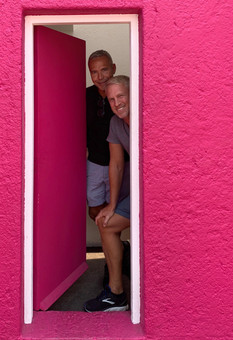

















































































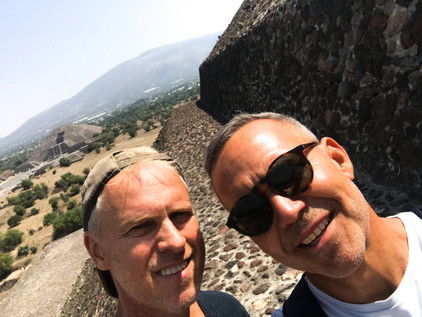





















































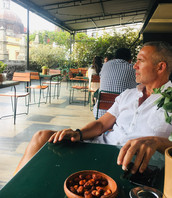



























































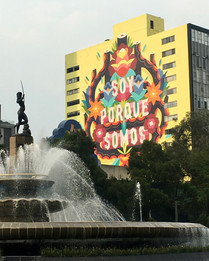











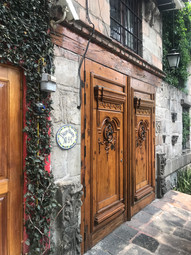




















Now, that's a good post fellas. On a more consumer oriented level, not only do I want the "Mexico is the shit" jacket, but also a time machine, so I can see the Temples of the Moon across the dynasties who lived there. Stay safe. P.
Wow. What a beautiful post about one of my favorite places on this earth. Well. Except for the misplaced dig at Sense8. Loved reading your take and loved sharing some of it with you. x